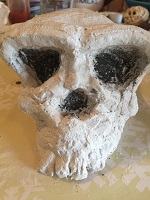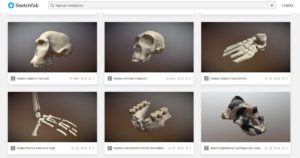Whether you’re tackling human evolution from a science perspective or as part of a Stone Age Britain topic, here are some resources collected from around the web that might be of use.

Making your own footprint casts
The Fossils and Dinosaurs topic from the Hamilton Trust is free to download and there is a block of work of five sessions specifically on human evolution that I wrote, from creating a family tree of the hominids, tracing human dispersal around the world and particularly exploring what it would be like for modern humans and Neanderthals to meet. There is also one lesson plan (session 5) and resources in a block on fossilised footprints that looks at human footprints at Laetoli in Tanzania, Happisburgh in Norfolk and Pehuen-Co in Argentina.
I also wrote the file for this handaxe found at Happisburgh for the Teaching History in 100 Objects website by the British Museum. Handaxes are some of the earliest tools created by ancient humans, and this one dates to around 850,000 years ago, the same time that early humans (probably Homo antecessor) left footprints in the mud. The file also includes links and images of other handaxes and gives you some teaching ideas on how to use these images to explore the capabilities of ancient humans.

Make your own modroc hominid skull
I wrote more in depth resources for the Coping with Climate project run by the Universities of Reading and Brighton. These include image banks, timelines, fact-sheets and instructions for doing practical activities to explore what kind of tasks ancient humans were able to do, focusing on Homo heidelbergensis in southern England and on Neanderthals and the first modern humans into Europe. They are free to download.
One area I haven’t worked in is creating 3D scans of images, but many other people have! This site at the Smithsonian Museum’s website has a fantastic collection of scans of tools, art objects and fossil hominids which can be searched by species name. There are lots of skulls so you can see how this changes over time.
The Smithsonian have also just created some new video resources called Snapshots in Time that introduce pupils to Swartkrans in South Africa, Olorgasailie in Kenya and Shanidar cave in Iraq. Each site and what was found there is introduced bit by bit in a series of videos that allow pauses for discussion of the significance and meaning of the finds, before the narrative is woven together in the final video.

Sketchfab 3D fossils
New scans of material related to human evolution are uploaded to Sketchfab all the time. There are 3D scans of tools, art objects, pendants, sub-fossil bones, caves, excavations and more. Just go to Sketchfab and search for human evolution or Palaeolithic.
Finally, for another great list of resources for teaching human evolution, but aimed at older students, go to Caitlin Schrein’s list on her website.
If you have any other suggestions for human evolution resources you like to use, let me know!

THE WOLF’S BOY by Susan Williams Beckhorn
“Beckhorn weaves together a striking account of survival and an engaging look into how the wolf became such an integral part of human life. Set in prehistoric times, Kai’s story is based on modern discoveries in France, where fossilized footprints of a boy and a canine were found walking side by side. VERDICT Strong writing and character development combined with a little-seen setting in middle grade historical fiction make this a first purchase.”―School Library Journal (starred review)
“This bracing, well-told story, laced with themes of self-responsibility, compassion, and honor, is both vital and nourishing.”
―Kirkus (starred review) Kirkus 2016 Best MG Novels
–ALSC Notable Book, (Older Readers) 2016
“Lyrically written and quietly told, this story about a boy coming of age at the beginning of the human world has no trouble speaking to modern readers. The bond between boy and canine—even one that’s just learning to be a dog—is timeless, and animal-lovers in particular will be touched by this telling.”—Booklist (starred review)
*Junior Library Guild Book Club Selection for December 2016*
“Beckhorn (Wind Rider) deftly sketches canine behavior, the bullying Kai suffers, and the oppressive suspicion of his people…strong adventure with a memorable central relationship offers insight into the beginnings of mankind’s long history with dogs.”—Publishers Weekly
“…this first-dog, coming-of- age, and survival story hits all the right psychological notes for the middle-school reader.”―BCCB
“Award-winning author Susan Williams Beckhorn delivers a powerful tale set in Paleolithic times. Inspired by modern discoveries, this carefully researched story creates a vivid picture of a time when the first wolves came to live with humans and forged a bond that lives on to this day.” –CBC
“In The Wolf’s Boy, the clean, accessible prose of Susan Williams Beckhorn (Wind Rider) draws readers into prehistory at a time when humans were on the verge of domesticating dogs. Fans of adventure, survival and animal stories will love Kai’s independent spirit and drive to live and thrive as he transcends his “bad foot” to find his own power in the world.”—Shelf Awareness
The Kirkus Prize 2016 Nominee, Young Readers; Cybils Awards Nominee
Bank Street Center for Children’s Literature Best Children’s Books of the Year List (starred)
Susan Williams Beckhorn is the award-winning author of half a dozen children’s books. Her novel, Wind Rider, a “first horse” story set in prehistoric Asia, received acclaim by KLIATT and Booklist, was a Book Sense Pick, and was selected to ALA’s Amelia Bloomer List for literature which promotes equality for women. Susan grew up in a family where kids, animals, & the outdoors are cherished. She lives and writes in Rexville, NY.
Hi Susan, thanks for sharing this. I look forward to getting hold of a copy and reading it! Kim